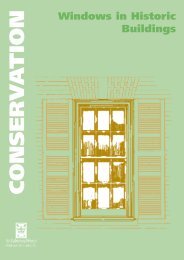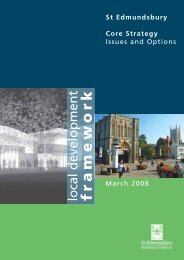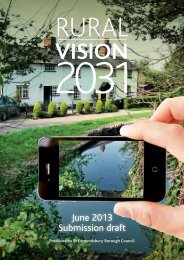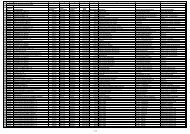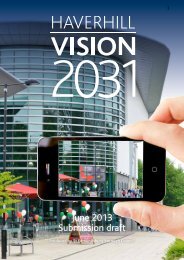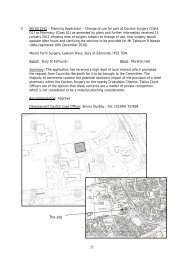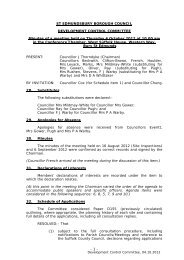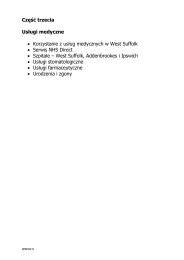St Edmundsbury Core Strategy (December 2010)
St Edmundsbury Core Strategy (December 2010)
St Edmundsbury Core Strategy (December 2010)
Create successful ePaper yourself
Turn your PDF publications into a flip-book with our unique Google optimized e-Paper software.
4.10 The <strong>Core</strong> <strong>St</strong>rategy makes provision for the construction of at least 9,000 newhomes in <strong>St</strong> <strong>Edmundsbury</strong> between 2008 and 2031. These homes will beprovided as follows:2008 – 2016 481 per annum2017 – 2021 577 per annum2022 – 2031 583 per annum4.11 A number of new homes have been constructed since 2001, the base datefor the East of England Plan and further sites have a valid planning consent and/orare currently under construction. Notwithstanding the current downturn in thehousing market, there remains a demand for new homes in the borough over thelong term to meet the demand created by natural growth in the existingpopulation and inward migration. The <strong>Core</strong> <strong>St</strong>rategy therefore needs to be in aposition to respond to this demand and identify, in broad terms, where at least9000 new homes will be built between 2008 and 2031 to meet the requirementsof the East of England Plan.4.12 We have reappraised all sites in the Replacement Borough Local Plan 2016that was adopted in 2006 and made provision for those sites that have not yet gotplanning permission to come forward in the LDF. In addition, we have undertakena separate <strong>St</strong>rategic Housing Land Availability Assessment (SHLAA) in accordancewith government guidelines that has identified available and deliverable sites overa 15 year timeframe. As the housing requirement is based on the situation at 1April 2008, it is considered important to take account of a number of larger sitesthat have either gained planning consent or have approved development briefs ormasterplans since that time. Their omission from the housing requirementscalculation would have a significant impact on the need to identify new sites forhomes.4.13 In the rural area there are a large number of villages that have continued todemonstrate that they are capable of delivering a significant proportion of newhomes. Policy CS4 sets out our settlement hierarchy for the Local DevelopmentFramework and some 44 settlements in the rural area. Our monitoring in the formof the Annual Monitoring Report and, prior to this, housing land availability studieshave demonstrated that there is an ongoing proportion of new homes in the ruralarea being built on sites within housing settlement boundaries that cannot beidentified through the plan making process. This is especially the case for sitesthat have an area of less that 0.2 hectares or a capacity of less than 10 newhomes and that are not identified in the <strong>St</strong>rategic Housing Land AvailabilityAssessment process. An allowance is made for 25 new homes a year to comeforward on windfall sites of less than 10 homes in the rural area. This equates toaround half a new home being constructed in each settlement every year. Ourmonitoring has identified that, on average, 93 new homes a year have been builton all sites in the rural area since 2001 and, on this basis, the provision for 25 newhomes a year on rural windfall sites is a very conservative estimate.4.14 <strong>St</strong>rategic directions of growth are identified on the Key Diagram in Bury <strong>St</strong>Edmunds and Haverhill and the estimate of the potential amount of housing thatcan be delivered in these areas is based on the environmental capacity andcommunity infrastructure requirements of each area. Specific policy requirementsare set out in Policies CS11 and CS12.32




